Sustainability Issues Faced by Kiama Municipal Council
VerifiedAdded on 2023/06/13
|8
|2757
|474
AI Summary
This article discusses the sustainability issues faced by Kiama Municipal Council and their impact on the non-urban environment. It covers issues related to land contamination, noise pollution, biodiversity, waste management, air pollution, and heritage conservation.
Contribute Materials
Your contribution can guide someone’s learning journey. Share your
documents today.
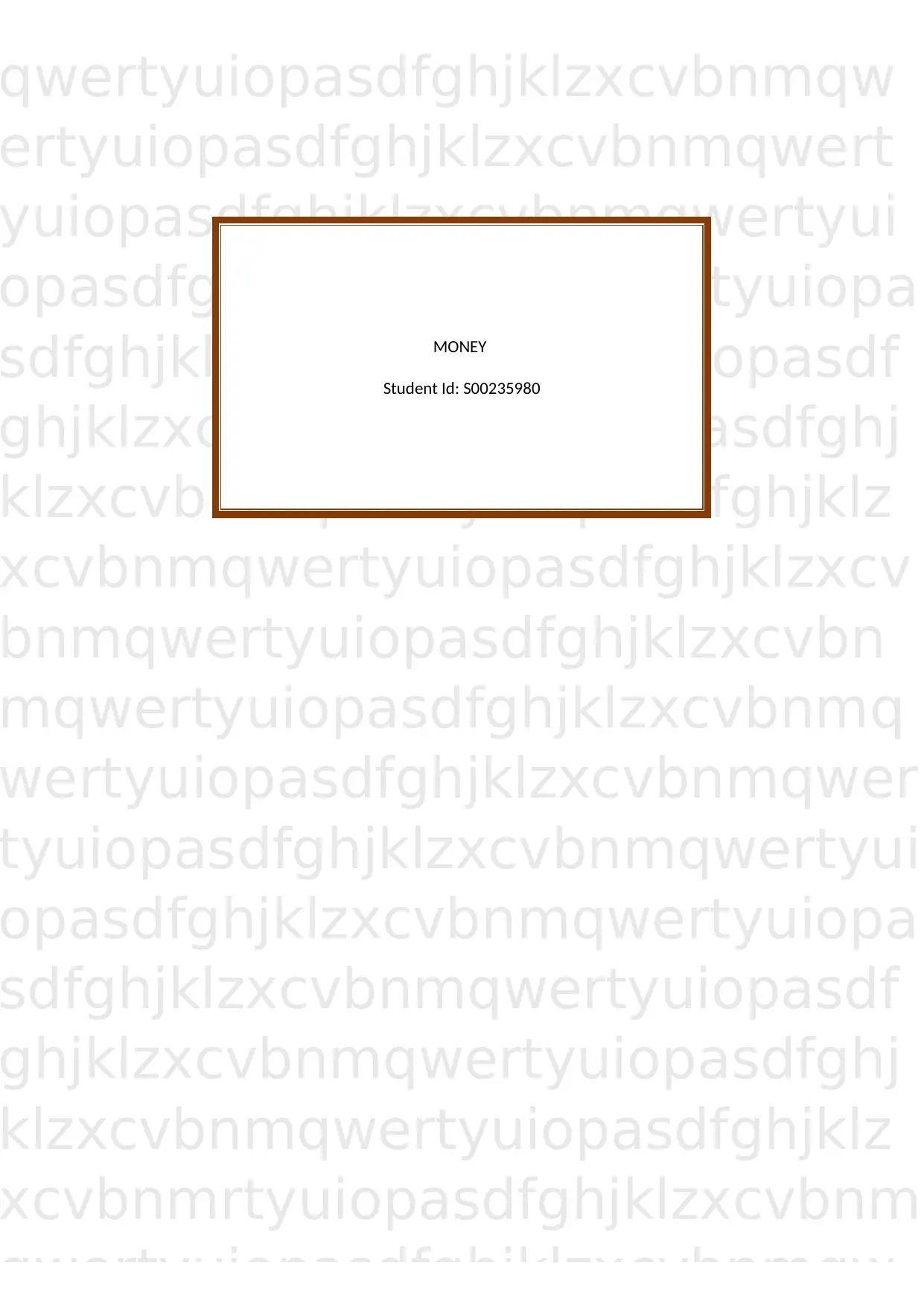
qwertyuiopasdfghjklzxcvbnmqw
ertyuiopasdfghjklzxcvbnmqwert
yuiopasdfghjklzxcvbnmqwertyui
opasdfghjklzxcvbnmqwertyuiopa
sdfghjklzxcvbnmqwertyuiopasdf
ghjklzxcvbnmqwertyuiopasdfghj
klzxcvbnmqwertyuiopasdfghjklz
xcvbnmqwertyuiopasdfghjklzxcv
bnmqwertyuiopasdfghjklzxcvbn
mqwertyuiopasdfghjklzxcvbnmq
wertyuiopasdfghjklzxcvbnmqwer
tyuiopasdfghjklzxcvbnmqwertyui
opasdfghjklzxcvbnmqwertyuiopa
sdfghjklzxcvbnmqwertyuiopasdf
ghjklzxcvbnmqwertyuiopasdfghj
klzxcvbnmqwertyuiopasdfghjklz
xcvbnmrtyuiopasdfghjklzxcvbnm
qwertyuiopasdfghjklzxcvbnmqw
MONEY
Student Id: S00235980
ertyuiopasdfghjklzxcvbnmqwert
yuiopasdfghjklzxcvbnmqwertyui
opasdfghjklzxcvbnmqwertyuiopa
sdfghjklzxcvbnmqwertyuiopasdf
ghjklzxcvbnmqwertyuiopasdfghj
klzxcvbnmqwertyuiopasdfghjklz
xcvbnmqwertyuiopasdfghjklzxcv
bnmqwertyuiopasdfghjklzxcvbn
mqwertyuiopasdfghjklzxcvbnmq
wertyuiopasdfghjklzxcvbnmqwer
tyuiopasdfghjklzxcvbnmqwertyui
opasdfghjklzxcvbnmqwertyuiopa
sdfghjklzxcvbnmqwertyuiopasdf
ghjklzxcvbnmqwertyuiopasdfghj
klzxcvbnmqwertyuiopasdfghjklz
xcvbnmrtyuiopasdfghjklzxcvbnm
qwertyuiopasdfghjklzxcvbnmqw
MONEY
Student Id: S00235980
Secure Best Marks with AI Grader
Need help grading? Try our AI Grader for instant feedback on your assignments.
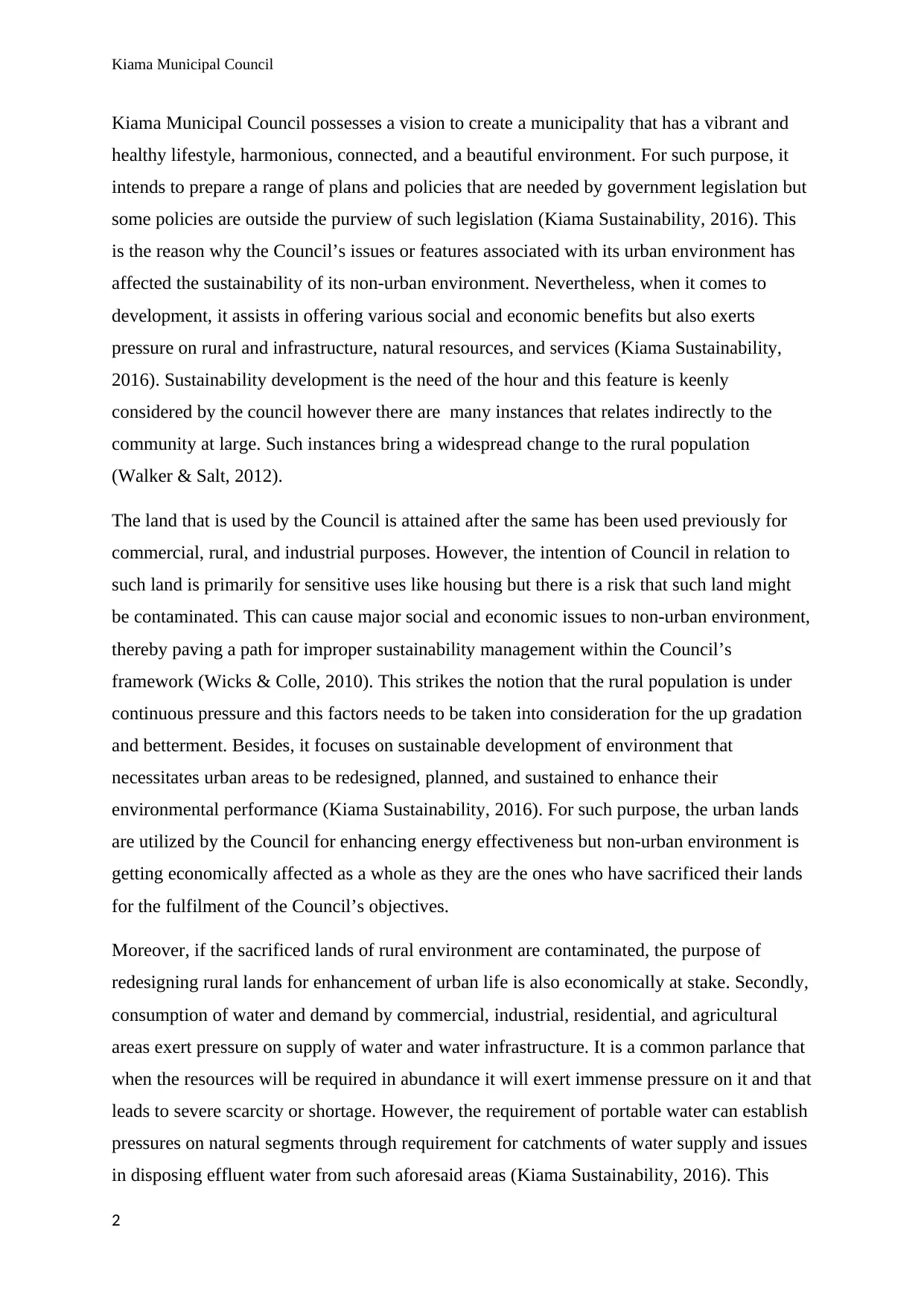
Kiama Municipal Council
Kiama Municipal Council possesses a vision to create a municipality that has a vibrant and
healthy lifestyle, harmonious, connected, and a beautiful environment. For such purpose, it
intends to prepare a range of plans and policies that are needed by government legislation but
some policies are outside the purview of such legislation (Kiama Sustainability, 2016). This
is the reason why the Council’s issues or features associated with its urban environment has
affected the sustainability of its non-urban environment. Nevertheless, when it comes to
development, it assists in offering various social and economic benefits but also exerts
pressure on rural and infrastructure, natural resources, and services (Kiama Sustainability,
2016). Sustainability development is the need of the hour and this feature is keenly
considered by the council however there are many instances that relates indirectly to the
community at large. Such instances bring a widespread change to the rural population
(Walker & Salt, 2012).
The land that is used by the Council is attained after the same has been used previously for
commercial, rural, and industrial purposes. However, the intention of Council in relation to
such land is primarily for sensitive uses like housing but there is a risk that such land might
be contaminated. This can cause major social and economic issues to non-urban environment,
thereby paving a path for improper sustainability management within the Council’s
framework (Wicks & Colle, 2010). This strikes the notion that the rural population is under
continuous pressure and this factors needs to be taken into consideration for the up gradation
and betterment. Besides, it focuses on sustainable development of environment that
necessitates urban areas to be redesigned, planned, and sustained to enhance their
environmental performance (Kiama Sustainability, 2016). For such purpose, the urban lands
are utilized by the Council for enhancing energy effectiveness but non-urban environment is
getting economically affected as a whole as they are the ones who have sacrificed their lands
for the fulfilment of the Council’s objectives.
Moreover, if the sacrificed lands of rural environment are contaminated, the purpose of
redesigning rural lands for enhancement of urban life is also economically at stake. Secondly,
consumption of water and demand by commercial, industrial, residential, and agricultural
areas exert pressure on supply of water and water infrastructure. It is a common parlance that
when the resources will be required in abundance it will exert immense pressure on it and that
leads to severe scarcity or shortage. However, the requirement of portable water can establish
pressures on natural segments through requirement for catchments of water supply and issues
in disposing effluent water from such aforesaid areas (Kiama Sustainability, 2016). This
2
Kiama Municipal Council possesses a vision to create a municipality that has a vibrant and
healthy lifestyle, harmonious, connected, and a beautiful environment. For such purpose, it
intends to prepare a range of plans and policies that are needed by government legislation but
some policies are outside the purview of such legislation (Kiama Sustainability, 2016). This
is the reason why the Council’s issues or features associated with its urban environment has
affected the sustainability of its non-urban environment. Nevertheless, when it comes to
development, it assists in offering various social and economic benefits but also exerts
pressure on rural and infrastructure, natural resources, and services (Kiama Sustainability,
2016). Sustainability development is the need of the hour and this feature is keenly
considered by the council however there are many instances that relates indirectly to the
community at large. Such instances bring a widespread change to the rural population
(Walker & Salt, 2012).
The land that is used by the Council is attained after the same has been used previously for
commercial, rural, and industrial purposes. However, the intention of Council in relation to
such land is primarily for sensitive uses like housing but there is a risk that such land might
be contaminated. This can cause major social and economic issues to non-urban environment,
thereby paving a path for improper sustainability management within the Council’s
framework (Wicks & Colle, 2010). This strikes the notion that the rural population is under
continuous pressure and this factors needs to be taken into consideration for the up gradation
and betterment. Besides, it focuses on sustainable development of environment that
necessitates urban areas to be redesigned, planned, and sustained to enhance their
environmental performance (Kiama Sustainability, 2016). For such purpose, the urban lands
are utilized by the Council for enhancing energy effectiveness but non-urban environment is
getting economically affected as a whole as they are the ones who have sacrificed their lands
for the fulfilment of the Council’s objectives.
Moreover, if the sacrificed lands of rural environment are contaminated, the purpose of
redesigning rural lands for enhancement of urban life is also economically at stake. Secondly,
consumption of water and demand by commercial, industrial, residential, and agricultural
areas exert pressure on supply of water and water infrastructure. It is a common parlance that
when the resources will be required in abundance it will exert immense pressure on it and that
leads to severe scarcity or shortage. However, the requirement of portable water can establish
pressures on natural segments through requirement for catchments of water supply and issues
in disposing effluent water from such aforesaid areas (Kiama Sustainability, 2016). This
2
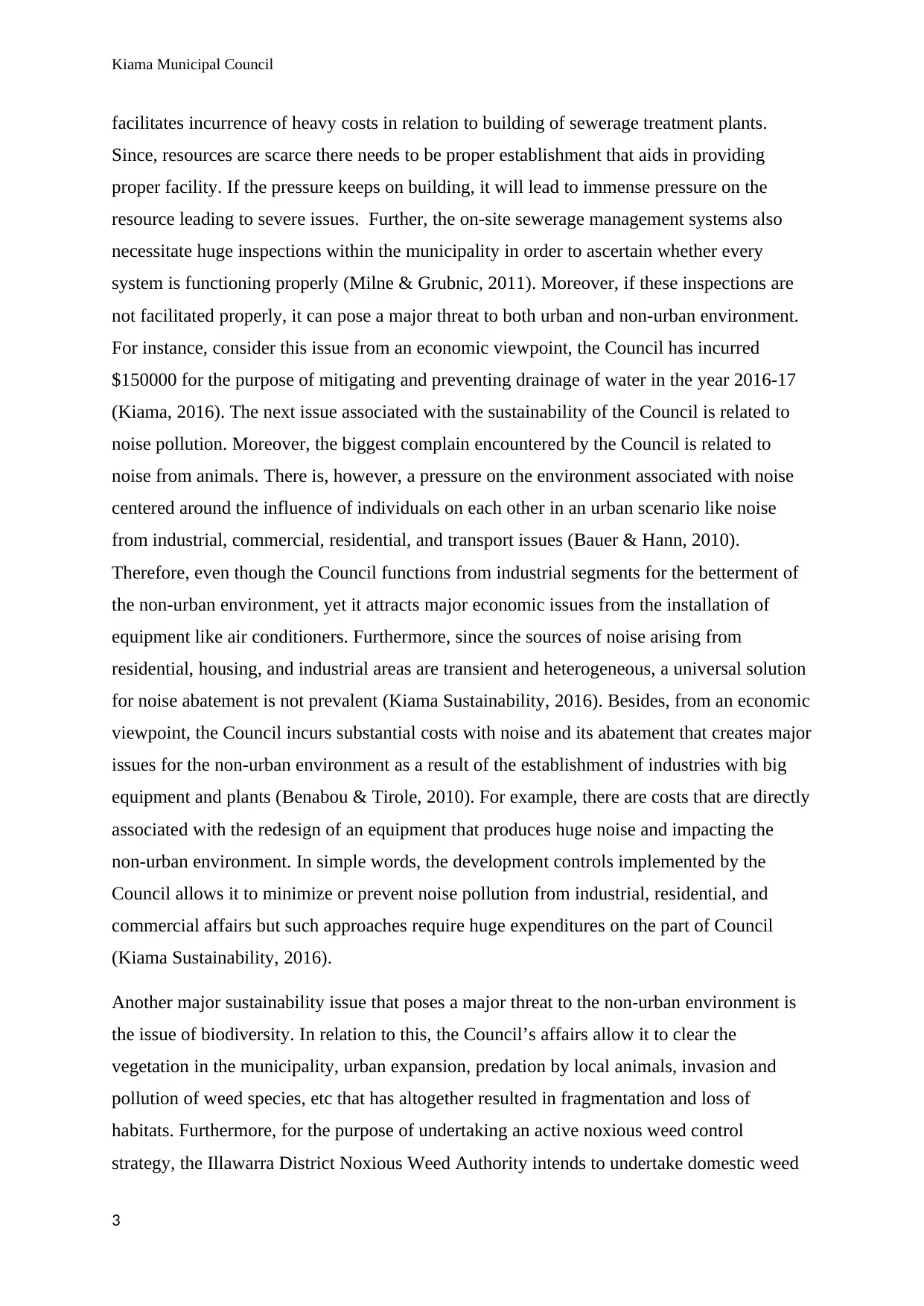
Kiama Municipal Council
facilitates incurrence of heavy costs in relation to building of sewerage treatment plants.
Since, resources are scarce there needs to be proper establishment that aids in providing
proper facility. If the pressure keeps on building, it will lead to immense pressure on the
resource leading to severe issues. Further, the on-site sewerage management systems also
necessitate huge inspections within the municipality in order to ascertain whether every
system is functioning properly (Milne & Grubnic, 2011). Moreover, if these inspections are
not facilitated properly, it can pose a major threat to both urban and non-urban environment.
For instance, consider this issue from an economic viewpoint, the Council has incurred
$150000 for the purpose of mitigating and preventing drainage of water in the year 2016-17
(Kiama, 2016). The next issue associated with the sustainability of the Council is related to
noise pollution. Moreover, the biggest complain encountered by the Council is related to
noise from animals. There is, however, a pressure on the environment associated with noise
centered around the influence of individuals on each other in an urban scenario like noise
from industrial, commercial, residential, and transport issues (Bauer & Hann, 2010).
Therefore, even though the Council functions from industrial segments for the betterment of
the non-urban environment, yet it attracts major economic issues from the installation of
equipment like air conditioners. Furthermore, since the sources of noise arising from
residential, housing, and industrial areas are transient and heterogeneous, a universal solution
for noise abatement is not prevalent (Kiama Sustainability, 2016). Besides, from an economic
viewpoint, the Council incurs substantial costs with noise and its abatement that creates major
issues for the non-urban environment as a result of the establishment of industries with big
equipment and plants (Benabou & Tirole, 2010). For example, there are costs that are directly
associated with the redesign of an equipment that produces huge noise and impacting the
non-urban environment. In simple words, the development controls implemented by the
Council allows it to minimize or prevent noise pollution from industrial, residential, and
commercial affairs but such approaches require huge expenditures on the part of Council
(Kiama Sustainability, 2016).
Another major sustainability issue that poses a major threat to the non-urban environment is
the issue of biodiversity. In relation to this, the Council’s affairs allow it to clear the
vegetation in the municipality, urban expansion, predation by local animals, invasion and
pollution of weed species, etc that has altogether resulted in fragmentation and loss of
habitats. Furthermore, for the purpose of undertaking an active noxious weed control
strategy, the Illawarra District Noxious Weed Authority intends to undertake domestic weed
3
facilitates incurrence of heavy costs in relation to building of sewerage treatment plants.
Since, resources are scarce there needs to be proper establishment that aids in providing
proper facility. If the pressure keeps on building, it will lead to immense pressure on the
resource leading to severe issues. Further, the on-site sewerage management systems also
necessitate huge inspections within the municipality in order to ascertain whether every
system is functioning properly (Milne & Grubnic, 2011). Moreover, if these inspections are
not facilitated properly, it can pose a major threat to both urban and non-urban environment.
For instance, consider this issue from an economic viewpoint, the Council has incurred
$150000 for the purpose of mitigating and preventing drainage of water in the year 2016-17
(Kiama, 2016). The next issue associated with the sustainability of the Council is related to
noise pollution. Moreover, the biggest complain encountered by the Council is related to
noise from animals. There is, however, a pressure on the environment associated with noise
centered around the influence of individuals on each other in an urban scenario like noise
from industrial, commercial, residential, and transport issues (Bauer & Hann, 2010).
Therefore, even though the Council functions from industrial segments for the betterment of
the non-urban environment, yet it attracts major economic issues from the installation of
equipment like air conditioners. Furthermore, since the sources of noise arising from
residential, housing, and industrial areas are transient and heterogeneous, a universal solution
for noise abatement is not prevalent (Kiama Sustainability, 2016). Besides, from an economic
viewpoint, the Council incurs substantial costs with noise and its abatement that creates major
issues for the non-urban environment as a result of the establishment of industries with big
equipment and plants (Benabou & Tirole, 2010). For example, there are costs that are directly
associated with the redesign of an equipment that produces huge noise and impacting the
non-urban environment. In simple words, the development controls implemented by the
Council allows it to minimize or prevent noise pollution from industrial, residential, and
commercial affairs but such approaches require huge expenditures on the part of Council
(Kiama Sustainability, 2016).
Another major sustainability issue that poses a major threat to the non-urban environment is
the issue of biodiversity. In relation to this, the Council’s affairs allow it to clear the
vegetation in the municipality, urban expansion, predation by local animals, invasion and
pollution of weed species, etc that has altogether resulted in fragmentation and loss of
habitats. Furthermore, for the purpose of undertaking an active noxious weed control
strategy, the Illawarra District Noxious Weed Authority intends to undertake domestic weed
3
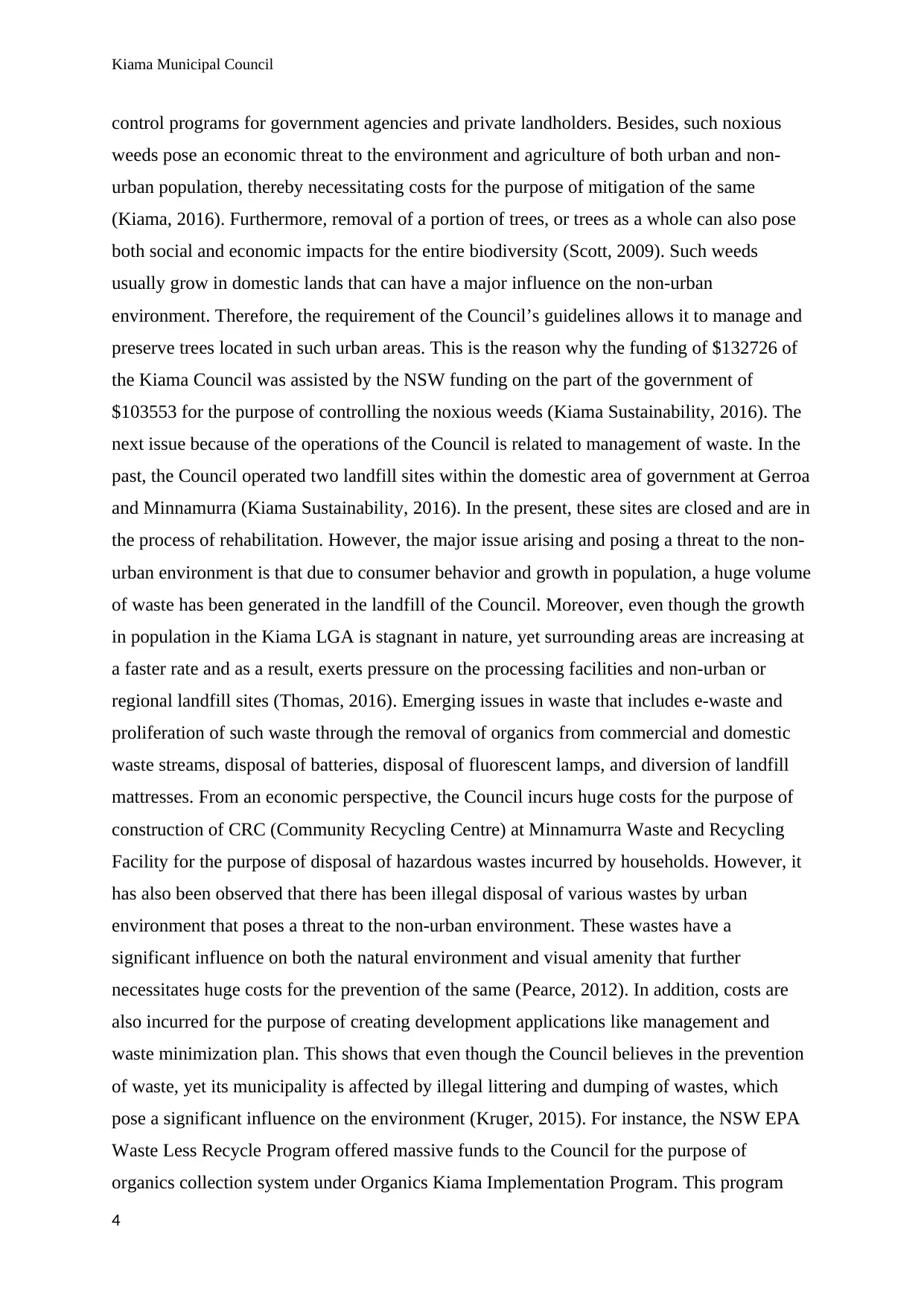
Kiama Municipal Council
control programs for government agencies and private landholders. Besides, such noxious
weeds pose an economic threat to the environment and agriculture of both urban and non-
urban population, thereby necessitating costs for the purpose of mitigation of the same
(Kiama, 2016). Furthermore, removal of a portion of trees, or trees as a whole can also pose
both social and economic impacts for the entire biodiversity (Scott, 2009). Such weeds
usually grow in domestic lands that can have a major influence on the non-urban
environment. Therefore, the requirement of the Council’s guidelines allows it to manage and
preserve trees located in such urban areas. This is the reason why the funding of $132726 of
the Kiama Council was assisted by the NSW funding on the part of the government of
$103553 for the purpose of controlling the noxious weeds (Kiama Sustainability, 2016). The
next issue because of the operations of the Council is related to management of waste. In the
past, the Council operated two landfill sites within the domestic area of government at Gerroa
and Minnamurra (Kiama Sustainability, 2016). In the present, these sites are closed and are in
the process of rehabilitation. However, the major issue arising and posing a threat to the non-
urban environment is that due to consumer behavior and growth in population, a huge volume
of waste has been generated in the landfill of the Council. Moreover, even though the growth
in population in the Kiama LGA is stagnant in nature, yet surrounding areas are increasing at
a faster rate and as a result, exerts pressure on the processing facilities and non-urban or
regional landfill sites (Thomas, 2016). Emerging issues in waste that includes e-waste and
proliferation of such waste through the removal of organics from commercial and domestic
waste streams, disposal of batteries, disposal of fluorescent lamps, and diversion of landfill
mattresses. From an economic perspective, the Council incurs huge costs for the purpose of
construction of CRC (Community Recycling Centre) at Minnamurra Waste and Recycling
Facility for the purpose of disposal of hazardous wastes incurred by households. However, it
has also been observed that there has been illegal disposal of various wastes by urban
environment that poses a threat to the non-urban environment. These wastes have a
significant influence on both the natural environment and visual amenity that further
necessitates huge costs for the prevention of the same (Pearce, 2012). In addition, costs are
also incurred for the purpose of creating development applications like management and
waste minimization plan. This shows that even though the Council believes in the prevention
of waste, yet its municipality is affected by illegal littering and dumping of wastes, which
pose a significant influence on the environment (Kruger, 2015). For instance, the NSW EPA
Waste Less Recycle Program offered massive funds to the Council for the purpose of
organics collection system under Organics Kiama Implementation Program. This program
4
control programs for government agencies and private landholders. Besides, such noxious
weeds pose an economic threat to the environment and agriculture of both urban and non-
urban population, thereby necessitating costs for the purpose of mitigation of the same
(Kiama, 2016). Furthermore, removal of a portion of trees, or trees as a whole can also pose
both social and economic impacts for the entire biodiversity (Scott, 2009). Such weeds
usually grow in domestic lands that can have a major influence on the non-urban
environment. Therefore, the requirement of the Council’s guidelines allows it to manage and
preserve trees located in such urban areas. This is the reason why the funding of $132726 of
the Kiama Council was assisted by the NSW funding on the part of the government of
$103553 for the purpose of controlling the noxious weeds (Kiama Sustainability, 2016). The
next issue because of the operations of the Council is related to management of waste. In the
past, the Council operated two landfill sites within the domestic area of government at Gerroa
and Minnamurra (Kiama Sustainability, 2016). In the present, these sites are closed and are in
the process of rehabilitation. However, the major issue arising and posing a threat to the non-
urban environment is that due to consumer behavior and growth in population, a huge volume
of waste has been generated in the landfill of the Council. Moreover, even though the growth
in population in the Kiama LGA is stagnant in nature, yet surrounding areas are increasing at
a faster rate and as a result, exerts pressure on the processing facilities and non-urban or
regional landfill sites (Thomas, 2016). Emerging issues in waste that includes e-waste and
proliferation of such waste through the removal of organics from commercial and domestic
waste streams, disposal of batteries, disposal of fluorescent lamps, and diversion of landfill
mattresses. From an economic perspective, the Council incurs huge costs for the purpose of
construction of CRC (Community Recycling Centre) at Minnamurra Waste and Recycling
Facility for the purpose of disposal of hazardous wastes incurred by households. However, it
has also been observed that there has been illegal disposal of various wastes by urban
environment that poses a threat to the non-urban environment. These wastes have a
significant influence on both the natural environment and visual amenity that further
necessitates huge costs for the prevention of the same (Pearce, 2012). In addition, costs are
also incurred for the purpose of creating development applications like management and
waste minimization plan. This shows that even though the Council believes in the prevention
of waste, yet its municipality is affected by illegal littering and dumping of wastes, which
pose a significant influence on the environment (Kruger, 2015). For instance, the NSW EPA
Waste Less Recycle Program offered massive funds to the Council for the purpose of
organics collection system under Organics Kiama Implementation Program. This program
4
Secure Best Marks with AI Grader
Need help grading? Try our AI Grader for instant feedback on your assignments.
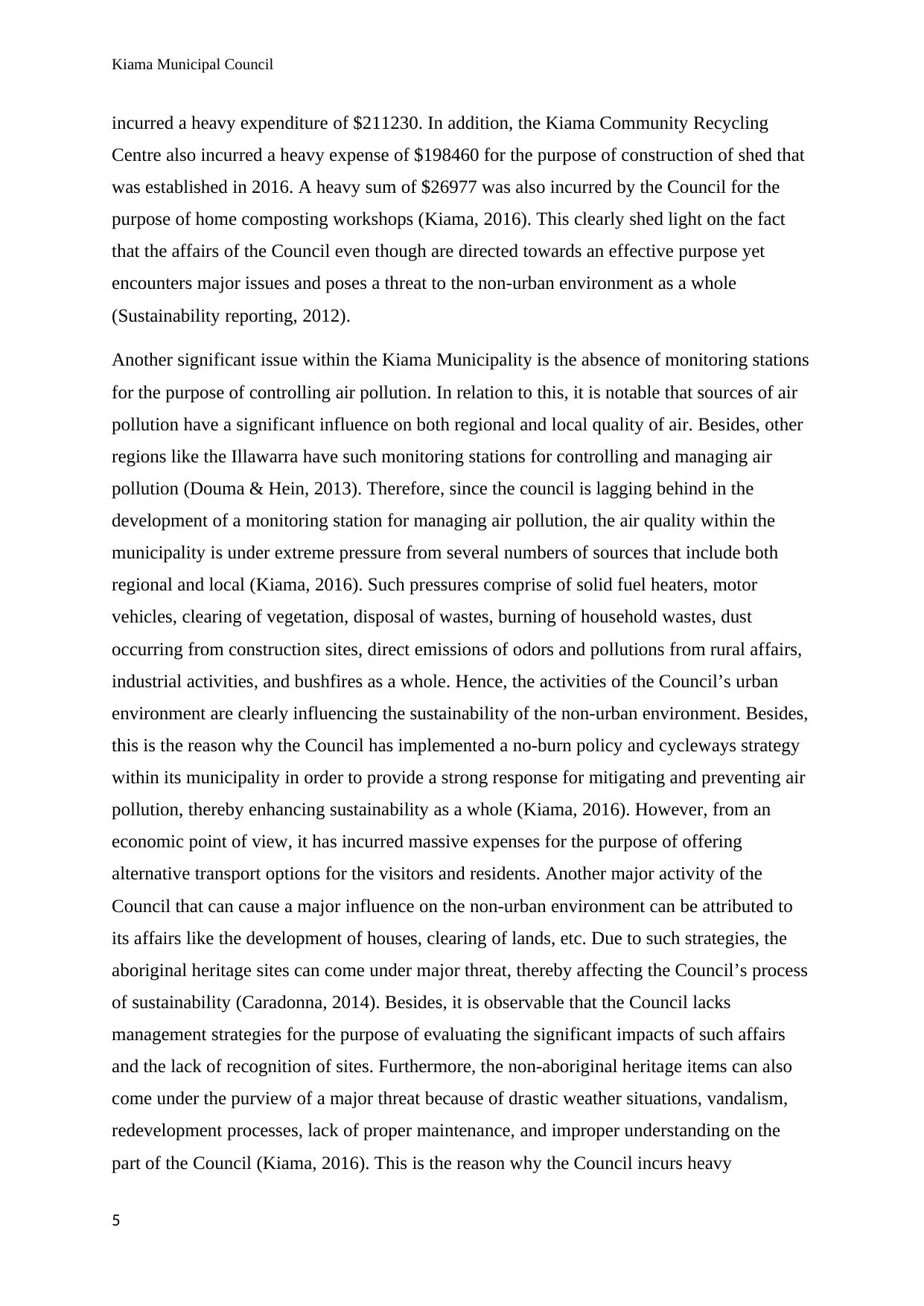
Kiama Municipal Council
incurred a heavy expenditure of $211230. In addition, the Kiama Community Recycling
Centre also incurred a heavy expense of $198460 for the purpose of construction of shed that
was established in 2016. A heavy sum of $26977 was also incurred by the Council for the
purpose of home composting workshops (Kiama, 2016). This clearly shed light on the fact
that the affairs of the Council even though are directed towards an effective purpose yet
encounters major issues and poses a threat to the non-urban environment as a whole
(Sustainability reporting, 2012).
Another significant issue within the Kiama Municipality is the absence of monitoring stations
for the purpose of controlling air pollution. In relation to this, it is notable that sources of air
pollution have a significant influence on both regional and local quality of air. Besides, other
regions like the Illawarra have such monitoring stations for controlling and managing air
pollution (Douma & Hein, 2013). Therefore, since the council is lagging behind in the
development of a monitoring station for managing air pollution, the air quality within the
municipality is under extreme pressure from several numbers of sources that include both
regional and local (Kiama, 2016). Such pressures comprise of solid fuel heaters, motor
vehicles, clearing of vegetation, disposal of wastes, burning of household wastes, dust
occurring from construction sites, direct emissions of odors and pollutions from rural affairs,
industrial activities, and bushfires as a whole. Hence, the activities of the Council’s urban
environment are clearly influencing the sustainability of the non-urban environment. Besides,
this is the reason why the Council has implemented a no-burn policy and cycleways strategy
within its municipality in order to provide a strong response for mitigating and preventing air
pollution, thereby enhancing sustainability as a whole (Kiama, 2016). However, from an
economic point of view, it has incurred massive expenses for the purpose of offering
alternative transport options for the visitors and residents. Another major activity of the
Council that can cause a major influence on the non-urban environment can be attributed to
its affairs like the development of houses, clearing of lands, etc. Due to such strategies, the
aboriginal heritage sites can come under major threat, thereby affecting the Council’s process
of sustainability (Caradonna, 2014). Besides, it is observable that the Council lacks
management strategies for the purpose of evaluating the significant impacts of such affairs
and the lack of recognition of sites. Furthermore, the non-aboriginal heritage items can also
come under the purview of a major threat because of drastic weather situations, vandalism,
redevelopment processes, lack of proper maintenance, and improper understanding on the
part of the Council (Kiama, 2016). This is the reason why the Council incurs heavy
5
incurred a heavy expenditure of $211230. In addition, the Kiama Community Recycling
Centre also incurred a heavy expense of $198460 for the purpose of construction of shed that
was established in 2016. A heavy sum of $26977 was also incurred by the Council for the
purpose of home composting workshops (Kiama, 2016). This clearly shed light on the fact
that the affairs of the Council even though are directed towards an effective purpose yet
encounters major issues and poses a threat to the non-urban environment as a whole
(Sustainability reporting, 2012).
Another significant issue within the Kiama Municipality is the absence of monitoring stations
for the purpose of controlling air pollution. In relation to this, it is notable that sources of air
pollution have a significant influence on both regional and local quality of air. Besides, other
regions like the Illawarra have such monitoring stations for controlling and managing air
pollution (Douma & Hein, 2013). Therefore, since the council is lagging behind in the
development of a monitoring station for managing air pollution, the air quality within the
municipality is under extreme pressure from several numbers of sources that include both
regional and local (Kiama, 2016). Such pressures comprise of solid fuel heaters, motor
vehicles, clearing of vegetation, disposal of wastes, burning of household wastes, dust
occurring from construction sites, direct emissions of odors and pollutions from rural affairs,
industrial activities, and bushfires as a whole. Hence, the activities of the Council’s urban
environment are clearly influencing the sustainability of the non-urban environment. Besides,
this is the reason why the Council has implemented a no-burn policy and cycleways strategy
within its municipality in order to provide a strong response for mitigating and preventing air
pollution, thereby enhancing sustainability as a whole (Kiama, 2016). However, from an
economic point of view, it has incurred massive expenses for the purpose of offering
alternative transport options for the visitors and residents. Another major activity of the
Council that can cause a major influence on the non-urban environment can be attributed to
its affairs like the development of houses, clearing of lands, etc. Due to such strategies, the
aboriginal heritage sites can come under major threat, thereby affecting the Council’s process
of sustainability (Caradonna, 2014). Besides, it is observable that the Council lacks
management strategies for the purpose of evaluating the significant impacts of such affairs
and the lack of recognition of sites. Furthermore, the non-aboriginal heritage items can also
come under the purview of a major threat because of drastic weather situations, vandalism,
redevelopment processes, lack of proper maintenance, and improper understanding on the
part of the Council (Kiama, 2016). This is the reason why the Council incurs heavy
5
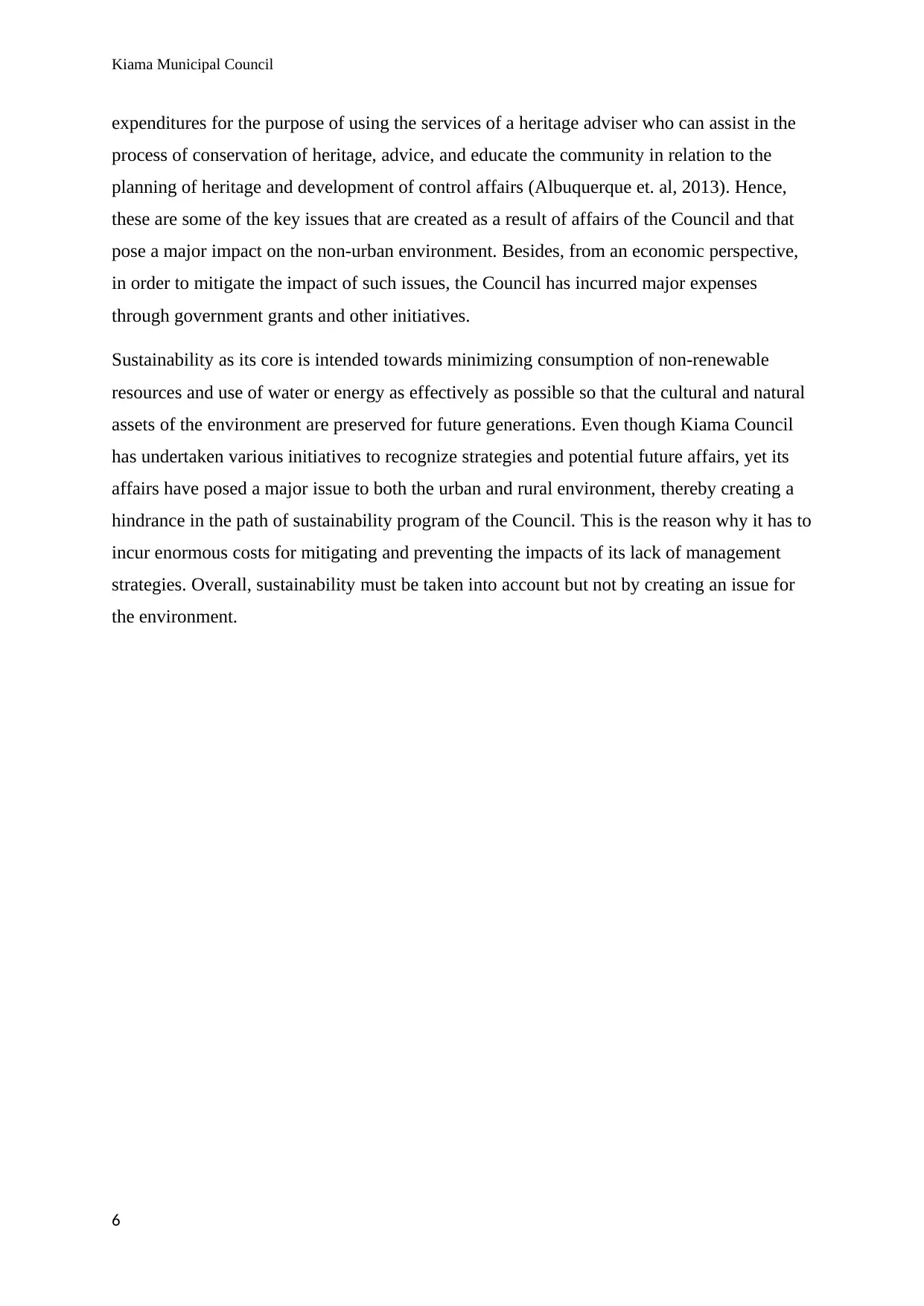
Kiama Municipal Council
expenditures for the purpose of using the services of a heritage adviser who can assist in the
process of conservation of heritage, advice, and educate the community in relation to the
planning of heritage and development of control affairs (Albuquerque et. al, 2013). Hence,
these are some of the key issues that are created as a result of affairs of the Council and that
pose a major impact on the non-urban environment. Besides, from an economic perspective,
in order to mitigate the impact of such issues, the Council has incurred major expenses
through government grants and other initiatives.
Sustainability as its core is intended towards minimizing consumption of non-renewable
resources and use of water or energy as effectively as possible so that the cultural and natural
assets of the environment are preserved for future generations. Even though Kiama Council
has undertaken various initiatives to recognize strategies and potential future affairs, yet its
affairs have posed a major issue to both the urban and rural environment, thereby creating a
hindrance in the path of sustainability program of the Council. This is the reason why it has to
incur enormous costs for mitigating and preventing the impacts of its lack of management
strategies. Overall, sustainability must be taken into account but not by creating an issue for
the environment.
6
expenditures for the purpose of using the services of a heritage adviser who can assist in the
process of conservation of heritage, advice, and educate the community in relation to the
planning of heritage and development of control affairs (Albuquerque et. al, 2013). Hence,
these are some of the key issues that are created as a result of affairs of the Council and that
pose a major impact on the non-urban environment. Besides, from an economic perspective,
in order to mitigate the impact of such issues, the Council has incurred major expenses
through government grants and other initiatives.
Sustainability as its core is intended towards minimizing consumption of non-renewable
resources and use of water or energy as effectively as possible so that the cultural and natural
assets of the environment are preserved for future generations. Even though Kiama Council
has undertaken various initiatives to recognize strategies and potential future affairs, yet its
affairs have posed a major issue to both the urban and rural environment, thereby creating a
hindrance in the path of sustainability program of the Council. This is the reason why it has to
incur enormous costs for mitigating and preventing the impacts of its lack of management
strategies. Overall, sustainability must be taken into account but not by creating an issue for
the environment.
6
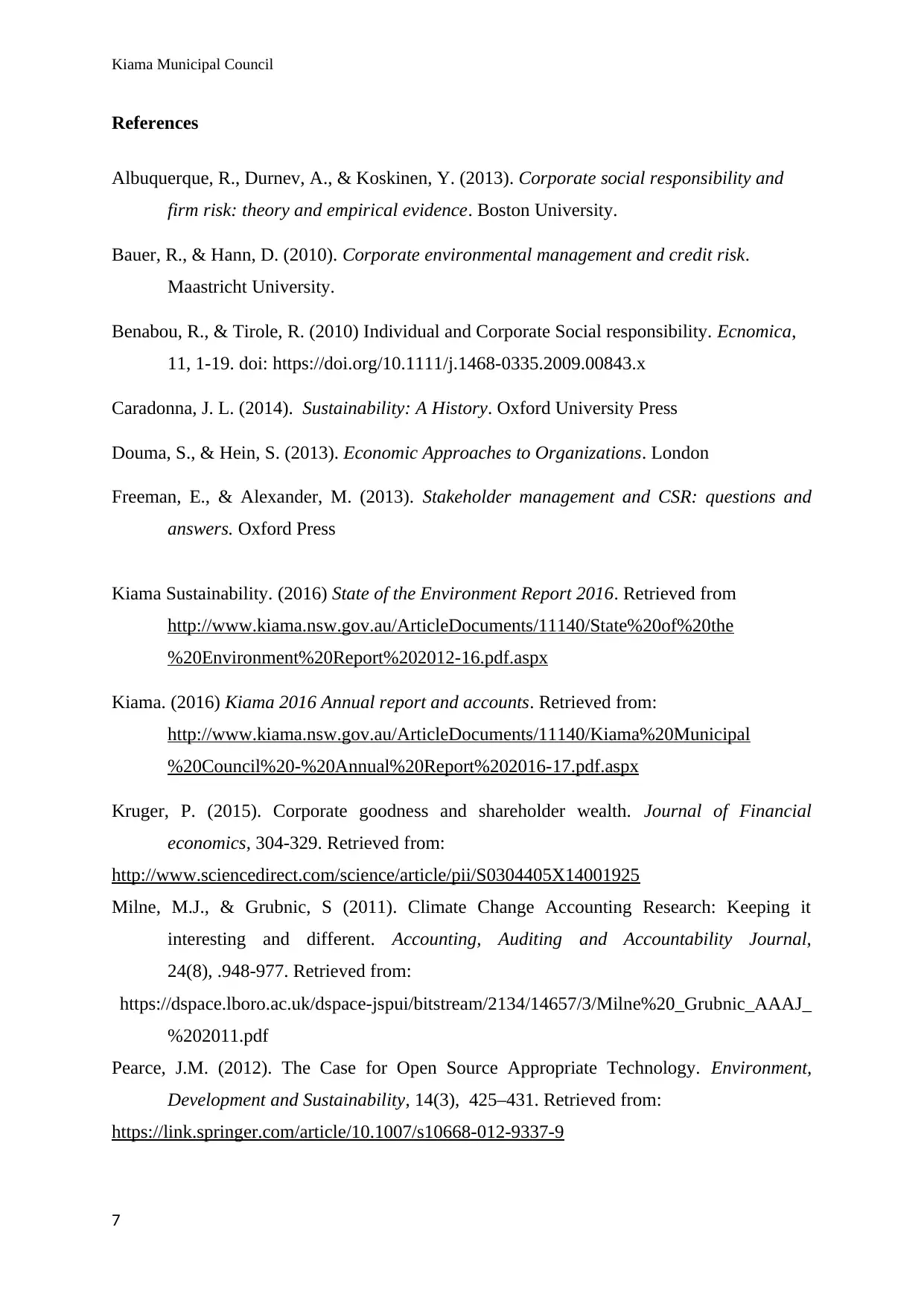
Kiama Municipal Council
References
Albuquerque, R., Durnev, A., & Koskinen, Y. (2013). Corporate social responsibility and
firm risk: theory and empirical evidence. Boston University.
Bauer, R., & Hann, D. (2010). Corporate environmental management and credit risk.
Maastricht University.
Benabou, R., & Tirole, R. (2010) Individual and Corporate Social responsibility. Ecnomica,
11, 1-19. doi: https://doi.org/10.1111/j.1468-0335.2009.00843.x
Caradonna, J. L. (2014). Sustainability: A History. Oxford University Press
Douma, S., & Hein, S. (2013). Economic Approaches to Organizations. London
Freeman, E., & Alexander, M. (2013). Stakeholder management and CSR: questions and
answers. Oxford Press
Kiama Sustainability. (2016) State of the Environment Report 2016. Retrieved from
http://www.kiama.nsw.gov.au/ArticleDocuments/11140/State%20of%20the
%20Environment%20Report%202012-16.pdf.aspx
Kiama. (2016) Kiama 2016 Annual report and accounts. Retrieved from:
http://www.kiama.nsw.gov.au/ArticleDocuments/11140/Kiama%20Municipal
%20Council%20-%20Annual%20Report%202016-17.pdf.aspx
Kruger, P. (2015). Corporate goodness and shareholder wealth. Journal of Financial
economics, 304-329. Retrieved from:
http://www.sciencedirect.com/science/article/pii/S0304405X14001925
Milne, M.J., & Grubnic, S (2011). Climate Change Accounting Research: Keeping it
interesting and different. Accounting, Auditing and Accountability Journal,
24(8), .948-977. Retrieved from:
https://dspace.lboro.ac.uk/dspace-jspui/bitstream/2134/14657/3/Milne%20_Grubnic_AAAJ_
%202011.pdf
Pearce, J.M. (2012). The Case for Open Source Appropriate Technology. Environment,
Development and Sustainability, 14(3), 425–431. Retrieved from:
https://link.springer.com/article/10.1007/s10668-012-9337-9
7
References
Albuquerque, R., Durnev, A., & Koskinen, Y. (2013). Corporate social responsibility and
firm risk: theory and empirical evidence. Boston University.
Bauer, R., & Hann, D. (2010). Corporate environmental management and credit risk.
Maastricht University.
Benabou, R., & Tirole, R. (2010) Individual and Corporate Social responsibility. Ecnomica,
11, 1-19. doi: https://doi.org/10.1111/j.1468-0335.2009.00843.x
Caradonna, J. L. (2014). Sustainability: A History. Oxford University Press
Douma, S., & Hein, S. (2013). Economic Approaches to Organizations. London
Freeman, E., & Alexander, M. (2013). Stakeholder management and CSR: questions and
answers. Oxford Press
Kiama Sustainability. (2016) State of the Environment Report 2016. Retrieved from
http://www.kiama.nsw.gov.au/ArticleDocuments/11140/State%20of%20the
%20Environment%20Report%202012-16.pdf.aspx
Kiama. (2016) Kiama 2016 Annual report and accounts. Retrieved from:
http://www.kiama.nsw.gov.au/ArticleDocuments/11140/Kiama%20Municipal
%20Council%20-%20Annual%20Report%202016-17.pdf.aspx
Kruger, P. (2015). Corporate goodness and shareholder wealth. Journal of Financial
economics, 304-329. Retrieved from:
http://www.sciencedirect.com/science/article/pii/S0304405X14001925
Milne, M.J., & Grubnic, S (2011). Climate Change Accounting Research: Keeping it
interesting and different. Accounting, Auditing and Accountability Journal,
24(8), .948-977. Retrieved from:
https://dspace.lboro.ac.uk/dspace-jspui/bitstream/2134/14657/3/Milne%20_Grubnic_AAAJ_
%202011.pdf
Pearce, J.M. (2012). The Case for Open Source Appropriate Technology. Environment,
Development and Sustainability, 14(3), 425–431. Retrieved from:
https://link.springer.com/article/10.1007/s10668-012-9337-9
7
Paraphrase This Document
Need a fresh take? Get an instant paraphrase of this document with our AI Paraphraser
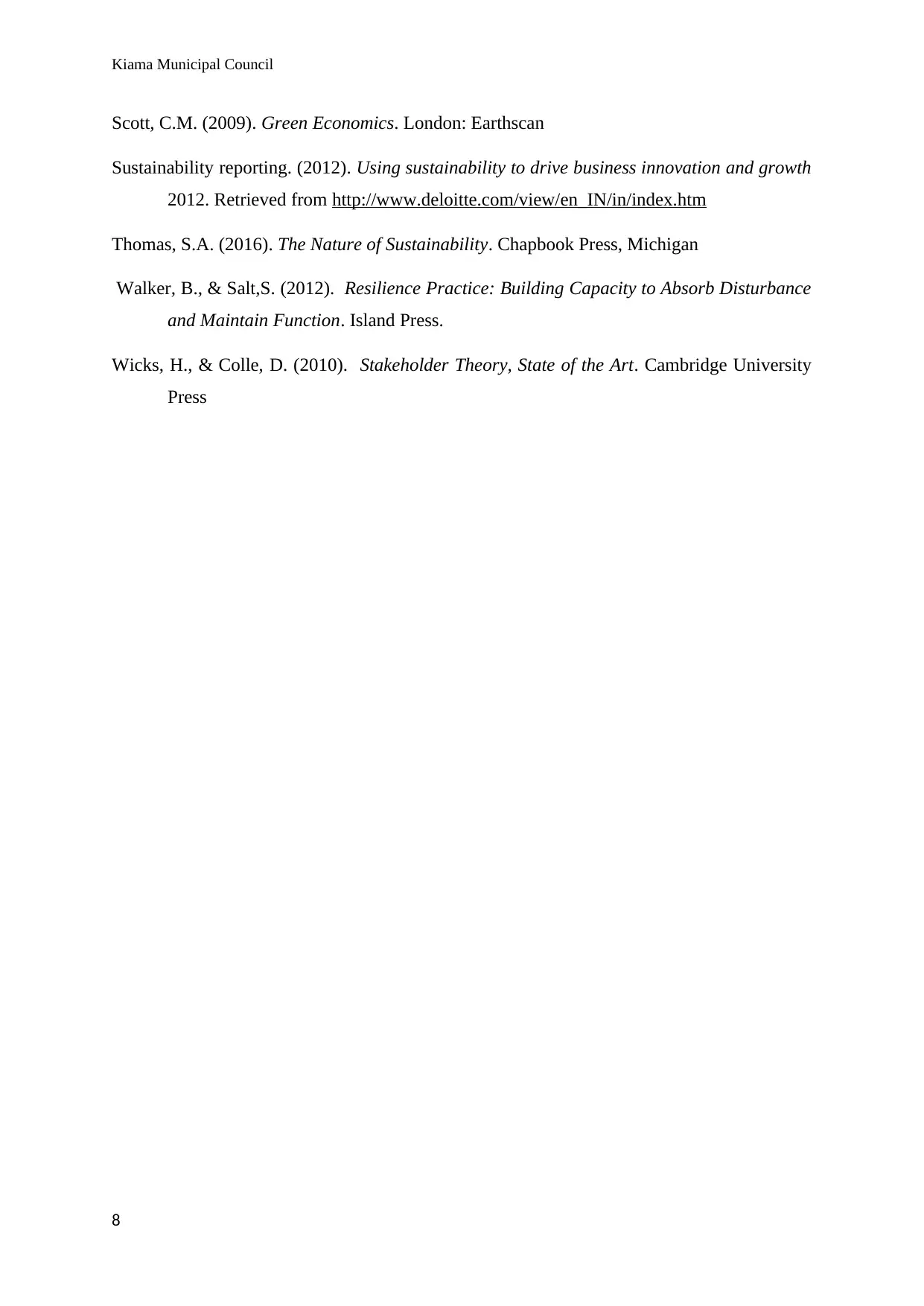
Kiama Municipal Council
Scott, C.M. (2009). Green Economics. London: Earthscan
Sustainability reporting. (2012). Using sustainability to drive business innovation and growth
2012. Retrieved from http://www.deloitte.com/view/en_IN/in/index.htm
Thomas, S.A. (2016). The Nature of Sustainability. Chapbook Press, Michigan
Walker, B., & Salt,S. (2012). Resilience Practice: Building Capacity to Absorb Disturbance
and Maintain Function. Island Press.
Wicks, H., & Colle, D. (2010). Stakeholder Theory, State of the Art. Cambridge University
Press
8
Scott, C.M. (2009). Green Economics. London: Earthscan
Sustainability reporting. (2012). Using sustainability to drive business innovation and growth
2012. Retrieved from http://www.deloitte.com/view/en_IN/in/index.htm
Thomas, S.A. (2016). The Nature of Sustainability. Chapbook Press, Michigan
Walker, B., & Salt,S. (2012). Resilience Practice: Building Capacity to Absorb Disturbance
and Maintain Function. Island Press.
Wicks, H., & Colle, D. (2010). Stakeholder Theory, State of the Art. Cambridge University
Press
8
1 out of 8
Your All-in-One AI-Powered Toolkit for Academic Success.
+13062052269
info@desklib.com
Available 24*7 on WhatsApp / Email
![[object Object]](/_next/static/media/star-bottom.7253800d.svg)
Unlock your academic potential
© 2024 | Zucol Services PVT LTD | All rights reserved.
